by Joe Cooper
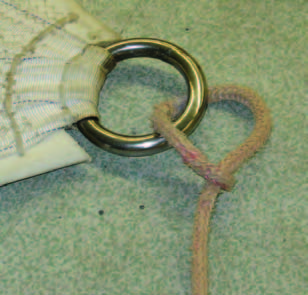 Editor’s note: This is the third and final installment in a series by Joe “Coop” Cooper, our Contributing Editor and the author of the monthly “Coop’s Corner” column, in which Coop is sharing his vast knowledge of shorthanded sailing and offering tips on cost-effective improvements to make your boat easier to handle with a small crew. If you missed Parts I and II, you can read them online at windcheckmagazine.com.
Editor’s note: This is the third and final installment in a series by Joe “Coop” Cooper, our Contributing Editor and the author of the monthly “Coop’s Corner” column, in which Coop is sharing his vast knowledge of shorthanded sailing and offering tips on cost-effective improvements to make your boat easier to handle with a small crew. If you missed Parts I and II, you can read them online at windcheckmagazine.com.
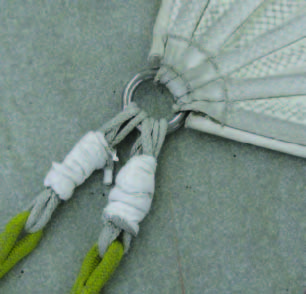 If your boat was designed before the mid-1990s, there is a good chance it was designed with a 150% headsail in mind. There are many reasons for this, but the upshot for shorthanded sailors is that it is just way too much sail in anything over about 10-12 knots of breeze. If you have one, you know. Why this is so would be the subject of another complete article. Far and away the preferred headsail for most boats is something in the 130-135% LP range (a headsail’s LP is the shortest distance between its clew and its luff). This is the size sail I will discuss, but the adjustments and principles apply to all headsails. There are four adjustments for headsails: a) halyard tension b) sheet tension c) sheet lead position and d) backstay tension. Not related to the shaping but a hang up, literally, that I see all the time is the large knots (because the sheets are thick) in the clew that hang up on the rigging making efficient tacking very hard and requiring lots of grinding after a tack.
If your boat was designed before the mid-1990s, there is a good chance it was designed with a 150% headsail in mind. There are many reasons for this, but the upshot for shorthanded sailors is that it is just way too much sail in anything over about 10-12 knots of breeze. If you have one, you know. Why this is so would be the subject of another complete article. Far and away the preferred headsail for most boats is something in the 130-135% LP range (a headsail’s LP is the shortest distance between its clew and its luff). This is the size sail I will discuss, but the adjustments and principles apply to all headsails. There are four adjustments for headsails: a) halyard tension b) sheet tension c) sheet lead position and d) backstay tension. Not related to the shaping but a hang up, literally, that I see all the time is the large knots (because the sheets are thick) in the clew that hang up on the rigging making efficient tacking very hard and requiring lots of grinding after a tack.
Luff Adjustment
You probably know that luff tension – either halyard or Cunningham – moves the shape of the sail forward. As the wind increases the most likely indicator that the luff needs adjusting, after the increased pressure on the helm, is the horizontal wrinkles emanating from the luff. This is not so much the sail stretching as it is the halyard stretching. The mechanics are as follows.
The clew is the most highly loaded corner of the sail, and of course as the wind increases loads increase everywhere. When close hauled, as you trim the headsail in tighter this load transfers load to the head (we hope) through the low stretch part of the sail, the leech. Because the halyard is certain to be some kind of polyester, it stretches, thus easing the load on the luff and creating the aforementioned “crow’s feet” wrinkles in the luff. The solution is low-stretch cordage, for all the same reasons as having it anywhere else on the boat.
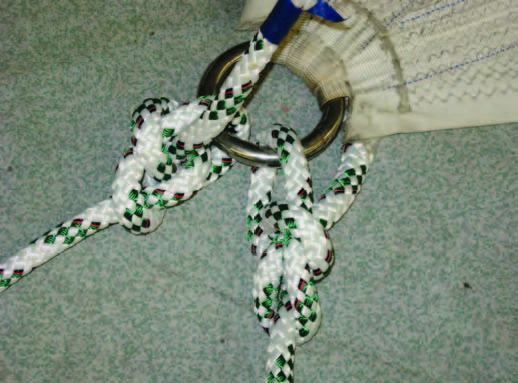 Sheet Tension
Sheet Tension
Unless you are trying to pinch up to avoid something, sheet tension is not much of a participant in the overall picture here. Generally for “regular” upwind trim, 2-4 inches off the spreader tips will work. (Note: If you are not used to having the sail trimmed in so hard, it will require more attention to steering because the “groove “ is narrower. Practice over time and you will get it.) How to measure? Put, say, five bands of contrasting colored electrical tape on the outboard end of the spreaders progressing in towards the mast at two-inch increments. This will help your guest trimmers when you do the Thursday night race, too.
Lead Position
The position of your jib lead controls the twist in the sail. Rule of thumb: When looking for pressure in light air, move it forward, say, one to three holes…experiment as necessary. In the sail’s wind range, move it to the position when the following occurs: When the lead is in the right spot for the sail, all the telltales on the luff will “break” (luff) at the same time. If the top ones break first, the lead is too far aft. If the bottom ones break first, the lead is too far forward. An upgrade to help all this is to make the cars adjustable on the track while the sail is sheeted in. This usually involves a moveable car with a suitable tackle.
Backstay Tension
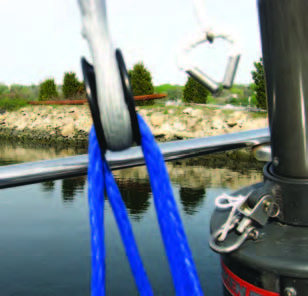
Tightening the backstay will both bend the mast and tighten the headstay. What is happening is that when the headsail is loaded, the stay will sag off to leeward some amount. When you tension the backstay the top of the mast bends aft. This loads the headstay and so reduces the sag in the headstay, so the middle of the stay moves forward, thus making the sail flatter. The sail is a fixed width and so if one side (the luff) is moved (forward), the draft in the sail moves closer to the imaginary straight line between the luff and the leech, thus making the sail flatter.
I note also that sailmakers design sails with differing amounts of shaping in the luff of sails. When discussing new sails with your sailmaker, give him as much information as you can about how you sail. You will end up with a better product.
Lastly, while not a sail adjustment, the size of the sheets and the bowlines everyone uses to tie the sheets to the sail are an impediment to a nice, smooth tack. You will have seen how they hang up on the rigging in a tack, usually requiring a lot of grinding to trim the sail in. Part of this is tacking coordination and technique, but a lot of it is the size of the knots. A way to minimize this is to again use thinner diameter cordage that will give a smaller fastening to the clew ring. There are three ways to reduce the bulk of the sheets at the clew: a) Have them spliced directly to the clew ring of the sail. b) Have longer soft eyes in the sheets and “cow hitch” (aka a luggage tag hitch) them to the clew ring. This allows you to remove them without cutting the splice. c) Use soft eyes in the end of the cordage and lash them to the clew ring with thin Spectra. One-eighth inch diameter is fine for most boats in the 30- to 40-foot range.
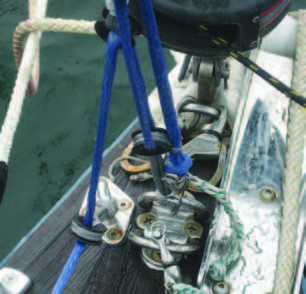
So much for the working sails. Now let’s look at some other sails. In the big picture a boat needs to be able to sail in winds from, practically speaking, five knots up to, for inshore operations, about 30 knots, and more like 45 knots or more offshore and from about 30-40 degrees to the wind to 180 degrees away from the wind. Unless you have a Nonsuch or similar rig, these wind angle and wind speed requirements lead to, at a minimum, two other sails, if you want to enjoy sailing in eight knots of wind off the wind and 20 plus knots more or less upwind. These two sails are a cruising kite, also known as an asymmetrical spinnaker, and a smaller headsail. Let’s start with a smaller jib.
The Solent Stay
Twenty knots true wind speed is a perfectly nice breeze for sailing but too much wind for an overlapping headsail. We know we are not going to clamber forward to change headsails when it is too windy. This is a given, right? Enter the “Solent” stay/sail system.
Introduced in the late 1980s or early 1990s by the French for use in the then-named BOC (a great example of useful trickle-down from the solo offshore racing world), the Solent is a stay located roughly a foot or so aft of the headstay and landing on the mast just under the headstay so the Solent stay roughly parallels the headstay. Some boat builders, Tartan and Outbound for instance, have begun to include this option on their standard package, albeit with a roller furler. Personally, for a smaller boat (under about 40-45 feet or so) I prefer a bare stay and sails with hanks. On this stay can be installed a variety of optional sails from a larger light air drifter-reacher (see below) to a small jib. I have consulted on the installation of upwards of a dozen of these retrofits in the past few years and the outcomes in every case are more sailing time, more control in stronger winds, and happier owners and first mates. The ingredients for a Solent stay are as follows.
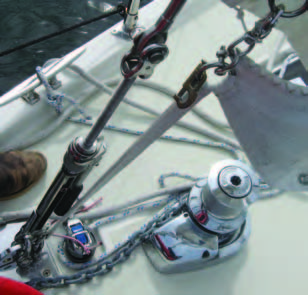
The stay itself, be it wire or cordage; a method of attachment to the top of the spar; a halyard and related blocks and clutch set up to lead the halyard to a suitable winch; a sheeting position; a method of attaching the stay to the deck; and a method of tensioning it. Again, the detail of such an installation is its own story but basically I like and have done the following.
Use low-stretch cordage for the stay, and it seems there are almost monthly upgrades in Dyneema that get stronger and more stretch resistant. Often a T-fitting will suffice for attaching the top of the stay to the spar. Many boats, especially French ones, already have a tang and sheave at the masthead for this set-up. Sometimes it is possible to use the sheave for the second Genoa halyard, if your boat is so equipped, for the Solent. At the deck level, I say again this stay ought to land as close as practicable to the headstay – not aft, as for a cutter arrangement. That makes for a very tall and skinny sail, which is not what one wants. My preferred arrangement is for a 2- or 3- or perhaps 4-part tackle with the tail led aft to a clutch and winch. More on this in a moment. There needs to be a tack fitting for the sail, and either tracks or another system called 3D to sheet the sail to, since it will be less than 100% LP and will typically sheet roughly outboard of the mast.
The Solent Sail
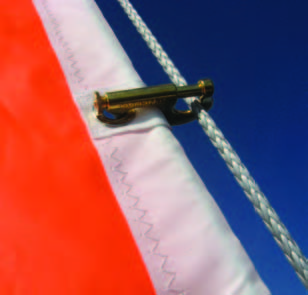 For the Solent sail, I find the following to be suitable. It need not be super duper high-test material; a suitable weight Dacron is perfectly fine. In fact, it is worth trolling the various used sail sites for a bargain given the number of hours it might be used per summer. Do not do this if you are preparing to go off cruising in the ocean. In that case, get one made for the boat. It need not be absolutely full-hoist. In fact, it can be even 2-3 feet from the top of the stay without harm. A higher clew is nice, as is a reef. Reefs are designed, engineered and installed in jibs the same way as reefs in mainsails. One discussion topic that consumes more beers than the other parts of the system is the hanks: traditional or “soft”? And in traditional I include the stainless steel Wichard type that one can use more or less one-handed.
For the Solent sail, I find the following to be suitable. It need not be super duper high-test material; a suitable weight Dacron is perfectly fine. In fact, it is worth trolling the various used sail sites for a bargain given the number of hours it might be used per summer. Do not do this if you are preparing to go off cruising in the ocean. In that case, get one made for the boat. It need not be absolutely full-hoist. In fact, it can be even 2-3 feet from the top of the stay without harm. A higher clew is nice, as is a reef. Reefs are designed, engineered and installed in jibs the same way as reefs in mainsails. One discussion topic that consumes more beers than the other parts of the system is the hanks: traditional or “soft”? And in traditional I include the stainless steel Wichard type that one can use more or less one-handed.
There is a good argument for using traditional side-action bronze piston hanks. They are the least expensive and they will slide over cordage stays just fine. They will need to be a larger size than for a wire stay because the cordage will be a larger diameter. Soft hanks are certainly lighter but they are more expensive, by a factor of at least two or more depending on the brand and they are finicky to put on and remove and you need both hands to do it. The Wichard ones are often seen on serious offshore boats but they too are expensive (and heavy) and are not necessary for this inshore near coastal model (say Long Island Sound to Maine). There is also the opportunity for the Wichard type to capture loose lines floating around the bow of the boat, like kite halyards or a headsail sheet (from the rolled up 135%) for instance.
The Adjustment Method
There are a couple of ways to adjust this stay and I much prefer a tackle led aft, for a few reasons. Typically after a few hours sailing, any such stay will have stretched some amount. This causes the sail to become fuller, which we do not want. With the mechanical adjusters, if one wants to re-tension the stay it is a drill. Ease the sheet – you will not adjust the stay with load on it – go forward sit on the deck and wind the screw to the point you want and come back aft and trim on. Well, you are not going to do that, are you? So, with a tackle the tension can be adjusted from the cockpit…almost without putting your hot chocolate down.
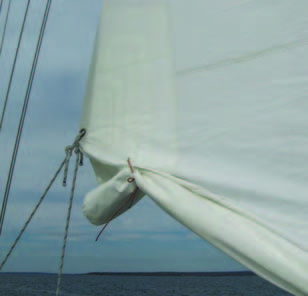 There are a couple of other advantages, too. If for some reason you have the Genoa deployed (a wind shift or change of course, for instance) but you find yourself having to tack in a hurry, it is a lot easier to cast off the tensioning line from the cockpit than to scramble forward to undo the mechanical adjuster. It is also possible to have a sail already hanked to the stay yet have the whole lot pulled aft to the cabin top and lashed down, ready for deployment. In this case, one person in the cockpit can pull the tension line, the person on deck can help ooch the sail forward over the dorades and whatnot, and the stay and sail are ready for a halyard and hoisting. Compared to going forward, hooking up the adjuster, getting the tension, and then having to hank the sail on and so on… If this sounds like a lot, it is concept I am trying to convey here. In practice, it is pretty easy and it is effective.
There are a couple of other advantages, too. If for some reason you have the Genoa deployed (a wind shift or change of course, for instance) but you find yourself having to tack in a hurry, it is a lot easier to cast off the tensioning line from the cockpit than to scramble forward to undo the mechanical adjuster. It is also possible to have a sail already hanked to the stay yet have the whole lot pulled aft to the cabin top and lashed down, ready for deployment. In this case, one person in the cockpit can pull the tension line, the person on deck can help ooch the sail forward over the dorades and whatnot, and the stay and sail are ready for a halyard and hoisting. Compared to going forward, hooking up the adjuster, getting the tension, and then having to hank the sail on and so on… If this sounds like a lot, it is concept I am trying to convey here. In practice, it is pretty easy and it is effective.
I did such an arrangement for a Beneteau 46 last spring using the ideas outlined here. The owner purchased a sail that was new but not delivered to the original owner and so was an order of magnitude cheaper than if it had been a dedicated purchase. We put hanks in it and away he went. I tested it with him after all the work with the following results. It was at least as fast as his Genoa in the conditions we used it in, the boat sailed flatter with less weather helm, and since it was about 90% LP it was a snap to tack. The overall idea is to have a fast, simple way to get more sailing out of your boat…sailing that is more fun and less stressful.
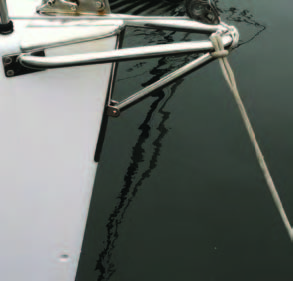 There is a second sail that might also be hanked onto this stay that will be very good value. This is a biggish, light and powerful sail, able to be stowed in a small space. The kids (or you) can sit, lie or sleep on it, it does not need to carefully flaked and fawned over as though it is the Shroud of Turin, and it has a pretty good range of utility. It is almost the perfect definition of Cooper’s Value Theory: If solution “A” costs 10 bucks, and solution “B” is 20 bucks, then “B” needs to be at a minimum at least two times better at solving the problem than “A.”
There is a second sail that might also be hanked onto this stay that will be very good value. This is a biggish, light and powerful sail, able to be stowed in a small space. The kids (or you) can sit, lie or sleep on it, it does not need to carefully flaked and fawned over as though it is the Shroud of Turin, and it has a pretty good range of utility. It is almost the perfect definition of Cooper’s Value Theory: If solution “A” costs 10 bucks, and solution “B” is 20 bucks, then “B” needs to be at a minimum at least two times better at solving the problem than “A.”
The sail of which I speak has various names, depending on which sailmaker’s ad you are looking at. At Hood we called it an MPG, but the name does not matter. Here are the characteristics you need: Roughly 135 to 140% LP (this will depend on the ratio of your boat’s J dimension [the base of the foretriangle, measured along the deck from the headstay pin to the front of the mast] to the boat’s LOA – higher ratios can use a smaller LP); light material – we would use 1.5 oz Nylon for up to about 40-42 foot boats usually; and a higher clew than “normal” for your boat, with geometry that allows the sail to be sheeted to the stern where the spinnaker blocks are. This sail can be used in the following situations.
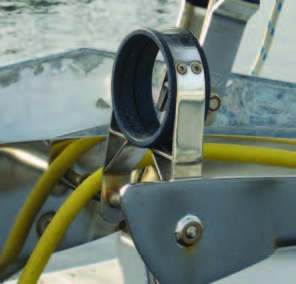 “Upwind” in light air, to say 8 to 9 knots true. Close to broad reaching in progressively higher wind speeds so that you might be able to use it in 15-18 knots true wind speed at 90 to 120 degrees apparent, more or less. Plotted on a Polar Diagram, it will overlap with the asymmetrical spinnaker in the range between close-hauled and beam reaching. It can also be used poled out, either alone or opposite the regular headsail if your sailing gets you out to long ocean passages. The key is the Nylon material, which is inexpensive relative to the “Code Zero” laminates and much more robust if you are caught in too much wind and the sail is flogging for a minute, whereas the light laminates will be more beat up. Being Nylon it has all the characteristics noted above with respect to folding and so on and it is small in bulk. It is really a high value sail with lots of advantages for the average sailor.
“Upwind” in light air, to say 8 to 9 knots true. Close to broad reaching in progressively higher wind speeds so that you might be able to use it in 15-18 knots true wind speed at 90 to 120 degrees apparent, more or less. Plotted on a Polar Diagram, it will overlap with the asymmetrical spinnaker in the range between close-hauled and beam reaching. It can also be used poled out, either alone or opposite the regular headsail if your sailing gets you out to long ocean passages. The key is the Nylon material, which is inexpensive relative to the “Code Zero” laminates and much more robust if you are caught in too much wind and the sail is flogging for a minute, whereas the light laminates will be more beat up. Being Nylon it has all the characteristics noted above with respect to folding and so on and it is small in bulk. It is really a high value sail with lots of advantages for the average sailor.
The Spinnaker Sock
Many of us have a cruising spinnaker of some kind, and ideally it is in a sock. Great! There are a couple of fine tune details when using the sock I have learned from hard experience over time.
Firstly, once you hoist the sock and set the sail, keep the sock control lines separated. This is because when the time comes to lower the sock/sail, one spends a few seconds or more squinting up the mast (with flashlight between the teeth at night) and flipping the lines back and forth trying to isolate the “down” line. In the right conditions, this is a great way to either get hurt or go overboard since you are distracted from the boat’s movement and focused on a frustrating detail. I find it much better to have the downhaul line isolated somewhere near the mast so that you do not have to stand in the middle of the foredeck and you have something to brace yourself against. In concert with this technique, I use two snatch blocks secured to the deck at perhaps 3-4 feet apart. This does two things. It keeps the lines apart and, with the down block, you can actually sit down and pull up from the deck, not down from a moving target in the sky. Being able to put your hands back to the same point with each pull is a much faster way of hauling on a line than trying to grab a moving target swinging around in the air. Finally, pulling up from the deck is preferred if something goes wrong and, like the rest of us, you try to stop it. You will be pulled in towards the block, not up in the air, before you are obliged to let go. Also, you do not have to worry as much about your balance when sitting down.
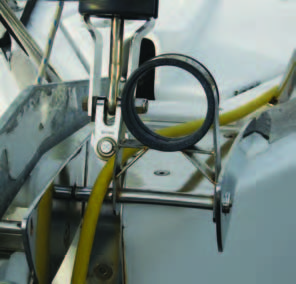
The Bowsprit
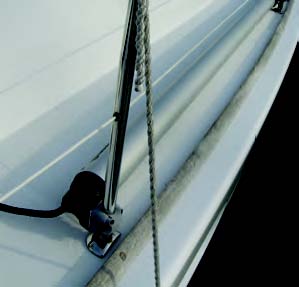 There is one last item for consideration regarding the kite. Install a small, removable bowsprit. Again, any boat designed before the mid-1990s will benefit from having a bowsprit for the kite. It need not be huge, merely long enough so that a straight line drawn from the masthead where the halyard is when the sail is hoisted clears the pulpit when it arrives at the tack block on the sprit. You can use the boathook to determine how far out the sprit needs to go. The sprit might then be something around 24 to 30 inches or so. The reason for this is that all such boats have a raked bow to degree or another and the pulpit (and the navigation lights and their stainless steel mounting plates) extends out past the stem. Include the anchor rollers, the anchor and the furling gear, and the life expectancy for the lower portion of a kite is low. They will invariably get holed when hung up on something. Likewise, if it is difficult to set and use, of course we won’t. A bowsprit makes all this go away, and makes setting the kite a lot easier. Thus we are more likely to use it, especially in lighter air, so we can turn the engine off and enjoy that which we brought the boat for in the first place…sailing.
There is one last item for consideration regarding the kite. Install a small, removable bowsprit. Again, any boat designed before the mid-1990s will benefit from having a bowsprit for the kite. It need not be huge, merely long enough so that a straight line drawn from the masthead where the halyard is when the sail is hoisted clears the pulpit when it arrives at the tack block on the sprit. You can use the boathook to determine how far out the sprit needs to go. The sprit might then be something around 24 to 30 inches or so. The reason for this is that all such boats have a raked bow to degree or another and the pulpit (and the navigation lights and their stainless steel mounting plates) extends out past the stem. Include the anchor rollers, the anchor and the furling gear, and the life expectancy for the lower portion of a kite is low. They will invariably get holed when hung up on something. Likewise, if it is difficult to set and use, of course we won’t. A bowsprit makes all this go away, and makes setting the kite a lot easier. Thus we are more likely to use it, especially in lighter air, so we can turn the engine off and enjoy that which we brought the boat for in the first place…sailing.
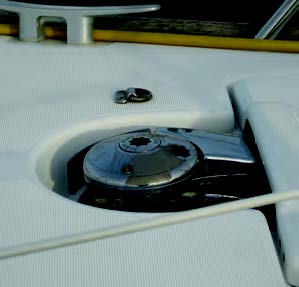
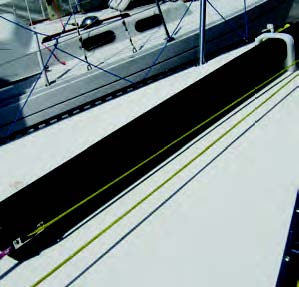
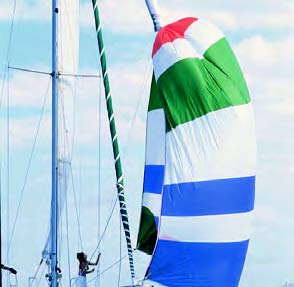


Australian born, Joe ‘Coop’ Cooper stayed in the US after the 1980 America’s Cup where he was the boat captain and sailed as Grinder/Sewer-man on Australia. His whole career has focused on sailing, especially the short-handed aspects of it. He lives in Middletown, RI where he coaches, consults and writes on his blog, joecoopersailing.com, when not paying attention to his wife, teenage son, dog, two cats and several, mainly small, boats.




